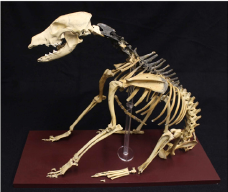More than 450 years ago, on the nineteenth of July in 1545, one of King Henry VIII's warships had an unfortunate accident off the cost of the Isle if Wight while trying to repel a French invasion force with their sights on England. The Mary Rose, together with her crew and the ship's dog, took a hit and went down in less than 50 feet of water. Silt and sediment deposited by the tides covered her, and she rested there until 1971, when she was rediscovered.
As it happened, the sediment created anoxic conditions that preserved some contents of the ship in near perfect conditions for four and a half centuries. Among the material excavated was the skeleton of a small male dog, maybe 18 months or two years old, and preserved well enough for the extraction of DNA from a tooth for analysis. The skeletal structure of the Mary Rose dog suggested a mongrel type, and DNA analysis of microsatellites suggested similarity with the Jack Russell or perhaps English Springer Spaniel. But since many of today's breeds didn't exist at the time this dog was alive, it's hard to say what he was except perhaps a "terrier-type" along for the trip to keep the rats at bay.
| Analysis of genes for coat color found that the dog was heterozygous for the agouti signal peptide protein (ASIP) and lacked the mutation of the E locus of the melanocortin MR1C gene responsible for the production of eumelanin. So as a best guest, the Mary Rose dog was likely some shade of brown. The surprising find coming out of the DNA analysis was the presence of a positive result for the autosomal recessive allele that causes hyperuricosuria in dogs, the defect in nitrogen metabolism that is linked to formation of stones in the kidneys and bladders of Dalmatians and more than 100 other breeds. Finding the mutation in the Mary Rose dog suggests that this is an ancient mutation that was present in the genome of the dog well before the creation of modern breeds. |
- Zouganelis GD, R Ogden, N Nahar, V Runfola, M Bonab, A Ardalan, D Radford, R Barnett, G Larson, A Hildred, M Jones, G Scarlett. 2014. An old dog and new tricks: genetic analysis of a Tudor dog recovered from the Mary Rose wreck. Forensic Science International 245: 51-57.


